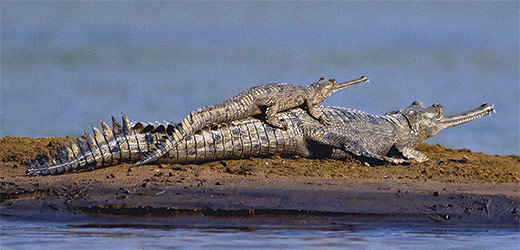


ASIAN ELEPHANT (Elephasmaximus): Formerly migratory elephants moved between India and Bardia. Now, however, barriers to migration have separated the previously mixing herds. Elephants live up to seventy years and females produce a calf when they are twenty. The gestation period is 22months. They have over 600 muscles in their trunk and can weigh up to 3 tonnes.
GREATER ONE HORNED RHINOCEROS (Rhinoceros unicornis): Largest and most heavily armoured of the three species of the Asian rhinos, this massive animal became extinct in Bardia during the second half of the last century. Since the late 1980's a total of 38 rhinos have been trans-located from Royal Chitwan National Park to two localities in Bardia. They are breeding and their numbers slowly expanding,despite some losses due to poaching. The rhino’s habitat is the riverine flood plain and sighting are most frequent from elephant back.
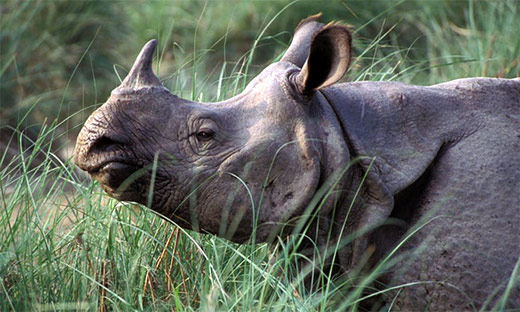

SPOTTED DEER OR CHITAL (Axis axis): This beautiful deer, which is found in large herds, is one of the tiger's favourite prey. They inhabit scrub forest and grassland aling the forest edges.they are especially active and visible during the spring months.
HOG DEER (Axis porcinus): Related to the spotted deer, but smaller and less graceful. The name is derived from its squat appearance and habit of running with the head down instead of bounding likeother deer. Sometimes found in groups, they prefer the grassland margins of riverbeds. They are wary animals with an acute sense of sight, smell and hearing. The gestation period is eight months.


BARKING DEER (Muntiacusmuntjak): This reddish coloured deer, seen singly or in pairs, is the smallest of the four kinds of deer in the park. It prefers densely forested hills but is sometimes found in the lowlands. The antlers are small, consisting of a short brow-tine and an unbranched beam. In does, tufts of bristly hair replace the horns.the name is derived from its alarm call which sound rather like the hoarse barking of a dog.
SAMBAR (Cervus unicolor): This is the largest of the deer in the sub-continent and a big stag may reach 500 to 700 pounds. It has a shaggy brown coat and the stags possess thick antlers with three tines-the full number of points being reached in the fourth year. Forested hillsides are their preferred habitat and their diet consists of grass, leaves and wild fruits. Their powers of sight are moderate, but scentand hearing acute. Sambars are sometimes seen in small herds.
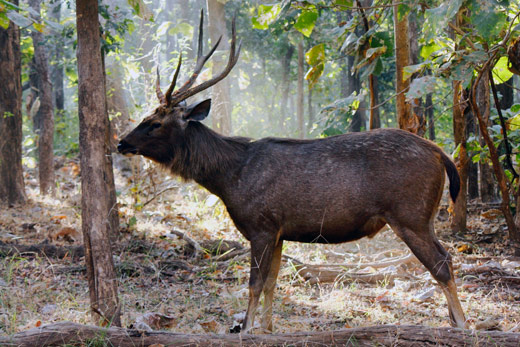
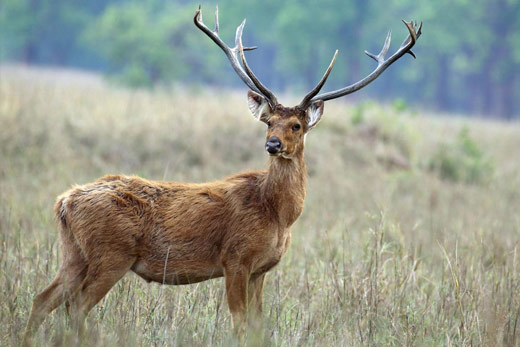
SWAMP DEER OR BARASINGHA (Cervusduvauceli): Slightly smaller and less nocturnal than its cousin the Sambar, swamp deer may be found congregating in moderate to large herds inthe grassland and woodland of the floodplain. 'Barasingha' means twelve horns, and refer to the massive antlers of the adult stags. They are one of the major prey species of the tiger and are seriously endangered.
SLOTH BEAR (melursusurinus): this large omnivore has a shaggy black coat and long, sharp claws with which it digs for temintes. It can be very aggressive if disturbed and males may reach six feet, when standing on their hind leags.


BLUE BULL OR NILGAI (Boselaphustragocamelus): Largest of the sub-continent's antelope species, the robust blue bull is found in small herds inhabiting scrubland and forest margins at the edge of the park. Adult males are a slate grey colour, with tufts of stiff black hair on the throat, and cone-like horns averagingeight inches in length. Females are a tawny broen and lack horns.
BLACK BUCK (Antilopecervicapra): A graceful antelope of the open plains, they may be seen in small herds. The bucks are black with a white eye ring and undersides, and their spiralledhornsmayreach twenty inches. The young males and hornless females are brown. There is a small population of blackbuck in open country near cultivated land to the southeast of the park. Therehavebeen attempts to introduce blackbuck, mainly zoo animals. into the park at BaghoraPhanta, a large meadow.
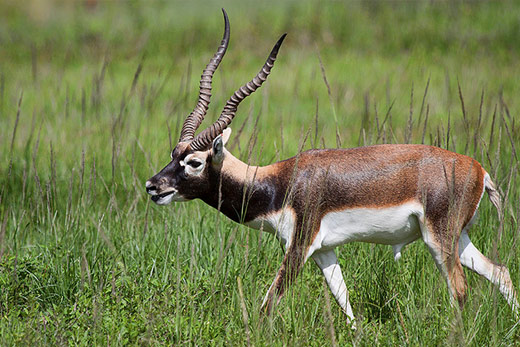

WILD BOAR (Sus Scrota): With its sparse black coat and bristled mane a large boar may stand three feet at the shoulder and weigh 300 pounds. The males haverazor sharp tusks. The wild boar is omnivorous ans its diet includes roots,tubers,insects, snakes and carrion. Thwy feed normally in the early morning or the late evening. Four to six young are bron at one time ane the monther shelters them in a heaped-up mass od grass or branches, which she builds befors she give birth.
ROYAL BENGAL TIGER (Panthers tigristigris): Regrettably, only around 1500 tigers of this sub-species rilay still exist in the sub-continent. Bardia has a good tiger population, with an estimated2530 breeding adults and a total of about 75 tigers of all ages. The preferred habitats of these cats are the grassland and riverine forest along the Karnali and Babai Rivers. Tigers achieve highest density where there is a variety andabundance of prey. Secretive and essentially solitary, this is a difficult animal to see in the wild, but Bardia is one of the very best places in the sub-continent to view a tiger.
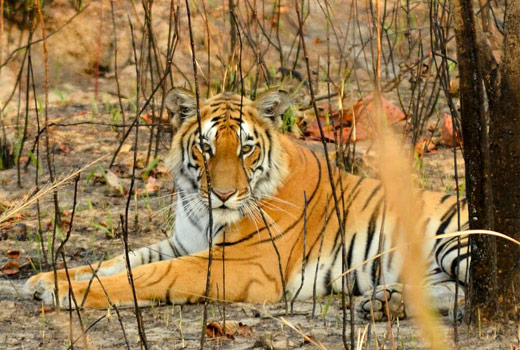

LEOPARD (Pantherapardus): Although leopards co-exist at Bardia with tigers, the latter and socially dominant is intolerant of the former. Leopards are not common in prime tiger habitat but are concentrated on the edge, dependent both on natural prey, taking some of the same species as the tiger (but generally smaller specimens), and on domestic livestock. Leopard sightings are less frequent than tiger sightings at Bardia.
WILD DOG (Cuonalpinus): A handsome reddish hunting dog with a dark muzzle and a black tipped tail, these predators run down their prey. In some parts ofthe sub-continent they hunt in packs of eight or more adults. They are rarely seen at Bardia and then onlysingly or in pairs.
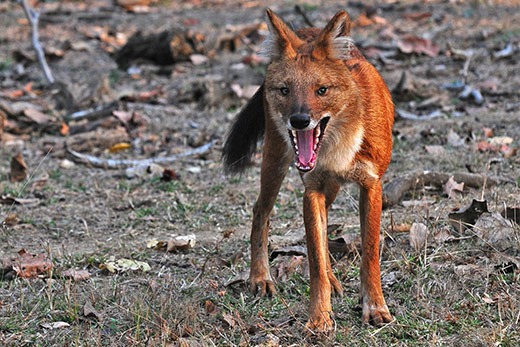
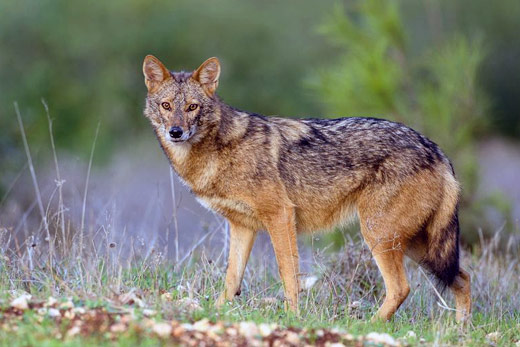
GOLDEN JACKAL (Canis aureus): A smaller relative of the wolf, the jackal's colouration varies from tawny brown to grey. Generally found in pairs, they hunt small mammals and birds, but are also scavengers. They aremainly nocturnal, and the jackal's howl may often be heard at night.
STRIPED HYENA (Hyaenahyaena): Scavenger/ predator found chiefly in scrubland at the edge of the park, it is tawny or grey with black transverse stripes and has powerful jaws and massive forequarters. Sightings are rare.


GANGETIC DOLPHIN (Platanistagangetica): This fresh water dolphin, up to eight feet in length, is found in the Karnali River. It surfaces to breathe about once a minute. The jaws of this almost sightless animal areadapted for browsing on bottom living crustaceans. Bardia is the best place in Nepal to see a fresh water dolphin.
GHARIAL CROCODILE (Gavialisgangeticum): this highly endangered mammal is the focus of an ongoing breeding programme at Chitwan National Park. Up to 5 metres in length, this fish-eating crocodile has a along slender snout, capped by the cartilaginous bulb,the cartilaginous bulb,theghara, which gives it its name.
